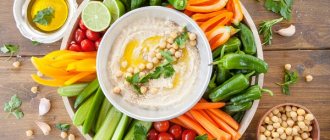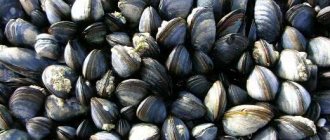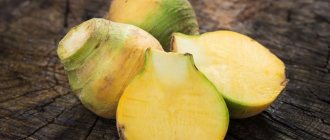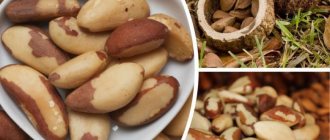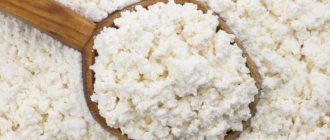Properties of parsley
Nutritional value and composition | Vitamins | Minerals
How much does parsley cost (average price for 1 bunch)?
Moscow and Moscow region.
16 rub.
The homeland of this greenery is the eastern coast of the Mediterranean Sea, more specifically Spain. There parsley is still found growing wild among the rocks, but close to water sources. The name parsley comes from the Greek word “petros”, which means “stone”, indicating the favorite place for the greenery to grow. In Greece, parsley began to be grown since ancient times, where it became a symbol of glory and joy. From the 9th century it began to spread throughout Europe.
Parsley was originally used as a medicine to heal wounds from poisonous insect bites. It was for this purpose that parsley began to be grown in Russia. Later, people realized that greens go well with vegetables, both fresh and stewed, as well as fish and meat. It is especially valuable that even with prolonged heat treatment, the beneficial properties of parsley are preserved, and its taste is only enhanced. The same is true with freshly frozen greens - nutrients and, accordingly, benefits for the body can be preserved in them for several months. The calorie content of parsley reaches 49 kcal. per 100 gr.
Dried parsley: calorie content per 100 grams - 276 Kcal. Proteins, fats, carbohydrates, chemical composition
Property Meaning
| Calorie content, kcal | 276 |
| Proteins, g | 22,42 |
| Carbohydrates, g | 21,26 |
| Fats, gr | 4,43 |
Dried parsley contains the following elements: Mono- and disaccharides, SFAs - Saturated fatty acids, Ash, Water, Dietary fiber, Sodium, Potassium, Phosphorus, Magnesium, Calcium, Copper, Manganese, Selenium, Zinc, Iron.
Micro and macro element Meaning
| Mono- and disaccharides, g. | 7,27 |
| SFA - Saturated fatty acids, g. | 0,115 |
| Zola, Mr. | 12,47 |
| Water, city | 9,02 |
| Dietary fiber, g. | 30,4 |
| Sodium, mg | 452 |
| Potassium, mg | 3805 |
| Phosphorus, mg | 351 |
| Magnesium, mg | 249 |
| Calcium, mg | 1468 |
| Copper, µg | 640 |
| Manganese, mg | 10,5 |
| Selenium, mcg | 29,3 |
| Zinc, mg | 4,75 |
| Iron, mg | 97,86 |
Dried parsley contains the following vitamins: Mono- and disaccharides, SFAs - Saturated fatty acids, Ash, Water, Dietary fiber, Sodium, Potassium, Phosphorus, Magnesium, Calcium, Copper, Manganese, Selenium, Zinc, Iron.
Vitamin Value
| Vitamin B1 (thiamine), mg | 0,172 |
| Vitamin B2 (riboflavin), mg | 1,23 |
| Vitamin B6 (pyridoxine), mg | 1,002 |
| Vitamin B9 (folic), mcg | 180 |
| Vitamin C, mg | 122 |
| Vitamin E (TE), mg | 6,91 |
| Vitamin K (phylloquinone), mcg | 1359,5 |
| Vitamin PP (Niacin equivalent), mg | 7,929 |
| Choline, mg | 97,1 |
| Vitamin A (VE), mcg | 509 |
| Beta-carotene, mg | 5,38 |
Product Kcal Proteins, g Fats, g Carbon, g
| Dried marjoram | 271 | 12,66 | 7,04 | 60,56 |
| Dried chervil | 237 | 23,2 | 3,9 | 49,1 |
| Dried tarragon | 295 | 22,77 | 7,24 | 42,82 |
| Dried basil | 233 | 22,98 | 4,07 | 47,75 |
| Dried mint | 285 | 19,93 | 6,03 | 52,04 |
| Dried rosemary | 331 | 4,88 | 15,22 | 64,06 |
| Dried paprika | 282 | 14,14 | 12,89 | 53,99 |
| Dried thyme | 276 | 9,11 | 7,43 | 63,94 |
| Dried sage | 315 | 10,63 | 12,75 | 60,73 |
| Dried onions | 218,5 | 8,4 | 2,8 | 42,6 |
| Dried garlic | 345 | 16 | 0,4 | 75 |
| Dried parsley | 276 | 22,42 | 4,43 | 21,26 |
| Dried dill | 253 | 19,96 | 4,36 | 42,22 |
| Dried cilantro | 216 | 3 | 54,5 | |
| Onion, dried (dehydrated), flakes | 349 | 8,95 | 0,46 | 74,08 |
| Coriander, leaves, dried | 279 | 21,93 | 4,78 | 41,7 |
| Onion powder | 347 | 10,12 | 1,05 | 74,97 |
| Spearmint, dried | 285 | 19,93 | 6,03 | 52,04 |
| Garlic powder | 332 | 16,8 | 0,76 | 62,81 |
| Onions, dried | 218,5 | 8,4 | 2,8 | 42,6 |
Property Meaning
| Calorie content, kcal | 51 |
| Proteins, g | 1,5 |
| Carbohydrates, g | 10,1 |
| Fats, gr | 0,6 |
Property Meaning
| Calorie content, kcal | 271 |
| Proteins, g | 31,3 |
| Carbohydrates, g | 9,68 |
| Fats, gr | 5,2 |
https://www..com/watch?v=ytdev
Freeze-dried parsley contains the following elements: Ash, Water, Dietary fiber, Sodium, Potassium, Phosphorus, Magnesium, Calcium, Copper, Manganese, Selenium, Zinc, Iron.
Micro and macro element Meaning
| Zola, Mr. | 19,12 |
| Water, city | 2 |
| Dietary fiber, g. | 32,7 |
| Sodium, mg | 391 |
| Potassium, mg | 6300 |
| Phosphorus, mg | 548 |
| Magnesium, mg | 372 |
| Calcium, mg | 176 |
| Copper, µg | 459 |
| Manganese, mg | 1,338 |
| Selenium, mcg | 32,3 |
| Zinc, mg | 6,11 |
| Iron, mg | 53,9 |
Freeze-dried parsley contains the following vitamins: Ash, Water, Dietary fiber, Sodium, Potassium, Phosphorus, Magnesium, Calcium, Copper, Manganese, Selenium, Zinc, Iron.
Vitamin Value
| Vitamin B1 (thiamine), mg | 1,04 |
| Vitamin B2 (riboflavin), mg | 2,26 |
| Vitamin B3 (pantothenic), mg | 2,516 |
| Vitamin B6 (pyridoxine), mg | 1,375 |
| Vitamin B9 (folic), mcg | 194 |
| Vitamin C, mg | 149 |
| Vitamin PP (Niacin equivalent), mg | 10,4 |
Product calculator
Enter the amount of Parsley Root to calculate its nutritional value
Property Value % of normal
| Calorie content, kcal | 51 | 2.55 | 2.55% |
| Proteins, g | 1,5 | 0.67 | 0.67% |
| Carbohydrates, g | 10,1 | 4 | 4% |
| Fats, gr | 0,6 | 0 | 0% |
Enter the amount of Dried Parsley to calculate its nutritional value
Property Value % of normal
| Calorie content, kcal | 276 | 13.8 | 13.8% |
| Proteins, g | 22,42 | 14.67 | 14.67% |
| Carbohydrates, g | 21,26 | 8.4 | 8.4% |
| Fats, gr | 4,43 | 9.09 | 9.09% |
Enter the amount of Parsley (root) to calculate its nutritional value
Enter the quantity of the product “Parsley, freeze-dried” to calculate its nutritional value
Property Value % of normal
| Calorie content, kcal | 271 | 13.55 | 13.55% |
| Proteins, g | 31,3 | 20.67 | 20.67% |
| Carbohydrates, g | 9,68 | 3.6 | 3.6% |
| Fats, gr | 5,2 | 11.36 | 11.36% |
Calorie content and nutritional value of dried parsley
Parsley (root) contains the following elements: Mono- and disaccharides, SFA - Saturated fatty acids, Ash, Starch, Water, Organic acids, Dietary fiber, Unsaturated fatty acids, Sodium, Potassium, Phosphorus, Magnesium, Calcium, Iron.
Micro and macro element Meaning
| Mono- and disaccharides, g. | 6,1 |
| SFA - Saturated fatty acids, g. | 0,2 |
| Zola, Mr. | 1,5 |
| Starch, Mr. | 4 |
| Water, city | 83 |
| Organic acids, g. | 0,1 |
| Dietary fiber, g. | 3,2 |
| Unsaturated fatty acids, g | 0,2 |
| Sodium, mg | 8 |
| Potassium, mg | 342 |
| Phosphorus, mg | 73 |
| Magnesium, mg | 22 |
| Calcium, mg | 57 |
| Iron, mg | 0,7 |
Parsley root contains the following elements: Mono- and disaccharides, SFA - Saturated fatty acids, PUFA - Polyunsaturated fatty acids, Ash, Starch, Water, Organic acids, Dietary fiber, Sodium, Potassium, Phosphorus, Magnesium, Calcium, Iron.
Micro and macro element Meaning
| Mono- and disaccharides, g. | 6,1 |
| SFA - Saturated fatty acids, g. | 0,2 |
| PUFA - Polyunsaturated fatty acids, g. | 0,2 |
| Zola, Mr. | 1,5 |
| Starch, Mr. | 4 |
| Water, city | 83 |
| Organic acids, g. | 0,1 |
| Dietary fiber, g. | 3,2 |
| Sodium, mg | 8 |
| Potassium, mg | 342 |
| Phosphorus, mg | 73 |
| Magnesium, mg | 22 |
| Calcium, mg | 57 |
| Iron, mg | 0,7 |
Vitamins in dried parsley
Parsley (root) contains the following vitamins: Mono- and disaccharides, SFA - Saturated fatty acids, Ash, Starch, Water, Organic acids, Dietary fiber, Unsaturated fatty acids, Sodium, Potassium, Phosphorus, Magnesium, Calcium, Iron.
Vitamin Value
| Vitamin B1 (thiamine), mg | 0,08 |
| Vitamin B2 (riboflavin), mg | 0,1 |
| Vitamin B6 (pyridoxine), mg | 0,6 |
| Vitamin B9 (folic), mcg | 24 |
| Vitamin C, mg | 35 |
| Vitamin E (TE), mg | 0,1 |
| Vitamin PP (Niacin equivalent), mg | 1,3 |
| Vitamin A (VE), mcg | 2 |
| Beta-carotene, mg | 0,01 |
| Vitamin PP, mg | 1 |
https://www..com/watch?v=ytpress
Parsley root contains the following vitamins: Mono- and disaccharides, SFA - Saturated fatty acids, PUFA - Polyunsaturated fatty acids, Ash, Starch, Water, Organic acids, Dietary fiber, Sodium, Potassium, Phosphorus, Magnesium, Calcium, Iron.
Vitamin Value
| Vitamin B1 (thiamine), mg | 0,08 |
| Vitamin B2 (riboflavin), mg | 0,1 |
| Vitamin B6 (pyridoxine), mg | 0,6 |
| Vitamin B9 (folic), mcg | 24 |
| Vitamin C, mg | 35 |
| Vitamin E (TE), mg | 0,1 |
| Vitamin PP (Niacin equivalent), mg | 1,3 |
| Vitamin A (VE), mcg | 2 |
| Beta-carotene, mg | 0,01 |
protein, calories, parsley, carbohydrate
Benefits of parsley
What is the secret of the miraculous properties of parsley? First of all, it contains a lot of vitamin C, significantly exceeding the same value in many vegetables and fruits. So 100 gr. Parsley contains almost two daily requirements of this invaluable vitamin. Thus, parsley is ideal for strengthening the immune system, for the treatment and prevention of seasonal vitamin deficiency, and scurvy. In terms of the amount of carotene, parsley is in no way inferior to carrots. In addition, it contains a significant amount of vitamins B1, B2, folic acid, potassium salts, iron and magnesium.
A unique substance, inulin, which is part of parsley, regulates the processes of glucose metabolism in human blood. Therefore, the benefits of parsley are revealed in the fight against diabetes. Parsley is also useful for various kidney diseases, bloating, intestinal colitis, gastritis, ulcers, and in general for any inflammatory processes and weakened vision. Parsley is indispensable for the fight against edema, of various origins - both renal and cardiac. Parsley also has an amazing effect on the oral cavity - it perfectly whitens teeth and strengthens the health of gums.
In addition to leaves, parsley seeds and roots are actively used in folk medicine. A decoction of them helps in eliminating freckles, age spots and acne on the face. After applying the decoction, the skin becomes fresher, the delicate skin around the eyes is toned and becomes smoother, facial wrinkles are smoothed out. Parsley also has a beneficial effect on hair growth; compresses made from crushed seeds are used to prevent baldness.
Parsley: calorie content and nutritional value – Health Portal
Parsley is an inconspicuous but irreplaceable “resident” of any garden. Vegetable growers willingly grow the spice in their summer cottages. And there are reasons for this. What is the secret of the popularity of parsley? The chemical composition and nutritional value of this plant give an excellent idea of its wonderful properties.
What it is
Parsley (Petrocelinum) is a biennial plant from the Apiaceae family. It grows up to 100 cm in height. Its stem is straight and branched. The root has a thickened shape.
The leaves of the plant are triangular, shiny, dark green in color with a slight glossy sheen on the upper side. The flowers are small, greenish-yellow. The oblong-shaped fruits appear in August. The crop grows in wild or cultivated form.
Currently, there are many varieties of this plant. The most popular variety is curly parsley (Petrocelinum crispum).
A little history
The plant has been known since ancient times. The Mediterranean coast is considered its homeland. However, early mentions of parsley survive in ancient Egyptian texts.
Legend has it that the plant grew on the site where a competition took place between the gods: Horus and Set, and was sprinkled with blood. Parsley was brought to Europe by the ancient Romans, who used the leaves of the plant to treat various diseases.
In cooking, parsley (the chemical composition is discussed below) began to be used later.
In Russia, the crop began to be grown at the beginning of the 19th century. The vegetable plant was called “bride” or “petrosilia”. Many folk superstitions, ceremonies, and rituals are associated with parsley. The plant has been cultivated everywhere since the 20th century. The spice became widespread in Europe, North America, and China. The crop tolerates frost well and prefers moist soil.
The nutritional value
Parsley is the leader in vitamin content among vegetable crops. The plant contains vitamins B, K, PP, and beta-carotene. Just 100 g of spicy herb can provide a person with a daily dose of ascorbic acid. Vegetables contain more of it than citrus fruits.
Parsley is a green herb whose chemical composition consists of active macroelements. The culture is rich in calcium, magnesium, iron, phosphorus. The spice contains flavonoids, important fatty oils, glycosides, and starch. Parsley contains proteins, fats, and carbohydrates.
The calorie content of the main vegetable crops is presented in the table for comparison.
All parts of the plant have a spicy taste, which is due to the presence of essential oils. It is most often a greenish liquid. The root of the plant contains about 7% essential oils, perhaps the most important of which is apiol. The chemical composition of the culture includes stearic and palmitic acid, adelgides, pectin substances, ketones, and phenols.
The calorie content of fresh parsley per 100 grams is only 36 calories. And the value of the product for the body is enormous. For comparison, let's take dill and parsley.
The calorie content of dill per 100 grams is 50 calories. People have been using this spicy plant for more than a millennium, and in Europe they learned about it after the 16th century.
Chemical composition of greens in the context of BZHU (share/% of the daily value):
- proteins – 3.7 g (4.51%);
- fats – 0.4 g (0.62%);
- carbohydrates – 7.6 g (5.94%).
The calorie content per 100 grams of parsley is significantly higher in comparison with other herbs: cilantro (24 cal), celery (15 cal), and basil (22 cal).
Secrets of popularity
Parsley is a spice with an ancient history, loved by many people. The plant has many advantages compared to other vegetable crops.
This is an indispensable component that is intensively used in cosmetology and medicine. Many products and preparations are based on parsley.
The chemical composition of this vegetable plant is characterized by a wealth of proteins and sugars (glucose, fructose, sucrose, as well as xylose in root vegetables).
The vegetable plant is included in many traditional dishes of different cuisines of the world. It is no coincidence that many vegetable growers fell in love with it. The culture is widespread and unpretentious to growing conditions. The vegetable plant is often found in the wild.
Cultivation does not have much effect on taste. But this is not the most important thing. Parsley is a rich storehouse of vitamins and macroelements important for humans.
The calorie content of fresh parsley per 100 grams practically corresponds to the nutritional value of citrus fruits.
What is the benefit
The vegetable plant has many wonderful features that are used in different areas of human life. The product is always at hand. It is easy to find and use at home.
People of all ages love this simple spice for its unique properties. Regular consumption of parsley helps strengthen vision, improve the condition of hair and skin, and whiten teeth.
Parsley can heal gums and relieve inflammatory diseases.
The medicinal effect of the plant on humans has been known for a long time. The spice has been used for a long time and effectively to treat itching after insect bites, increase potency, and regulate the menstrual cycle.
There are many folk recipes based on parsley that are passed down from generation to generation.
Drugs that contain spices increase immunity and have vasodilating properties.
Experts advise including parsley in any diet. It will help lower blood sugar and stabilize digestive processes in the body. The unique properties of parsley are determined by the chemical composition and nutritional value. Eating it regularly will improve your mood and maintain your vigor.
Contraindications
Parsley is a tasty and aromatic spice that is popular as a seasoning among all segments of the population. People of all ages prefer this humble vegetable plant. Experts recommend including the spice more often in your daily diet. Despite everything, there are some contraindications that must be taken into account.
Experts advise pregnant women not to consume parsley. The spice can cause kidney irritation and stimulate miscarriage. You should refrain from using the vegetable plant for certain diseases: cystitis, anemia, inflammation of the bladder, high blood pressure. This is due to the fact that the product has a diuretic effect.
There are no restrictions for regular consumption of the vegetable plant. However, everything is good in moderation. Abuse of the product can cause poisoning, nausea, headaches, stomach upset, and convulsions.
How to choose
You can be completely confident in the quality of the product only if the parsley was grown yourself. When purchasing spices, experts advise paying attention to some nuances. Purchasing a low-quality product can cause serious harm to human health. There are several simple tips that you need to consider when going to a store or market:
- The greens should look fresh and not wilted.
- The color of plants should be uniform and rich.
- Parsley sprigs should be neat and clean.
- The leaves should not show signs of fungal or bacterial diseases.
- The parsley package should not be damaged.
Application
Parsley is used in cooking, cosmetology, and medicine. For this purpose, all parts of the plant are used: tender shoots of the first year of cultivation, strong roots, succulent stems. Parsley is included in many seasonings.
The leaves and roots of the spice are used to flavor and decorate various traditional dishes. It is added to various marinades, sauces, and salads. The vegetable plant is consumed fresh, dried, or frozen.
The taste of the spice after heat treatment only intensifies and persists for a long time.
The spice is popular in cosmetology. It is included in many sprays, whitening masks, and anti-aging creams. The plant is often used at home to prepare various decoctions and tinctures. Particularly popular is parsley oil, which improves complexion and relieves swelling.
Parsley is an important source of vitamins and macroelements. The use of spices in medicine is extensive. The plant is used to produce drugs intended to stabilize metabolism, improve digestion, strengthen blood vessels, normalize blood pressure, treat anti-inflammatory diseases, and regulate the functioning of the thyroid gland.
Preparations from the seeds are used to treat malaria. The persistent diuretic effect and low calorie content make it possible to effectively use parsley in dietetics. The chemical composition and nutritional value distinguishes it from other vegetable crops.
Note to scholars
In conclusion, some interesting facts about the plant:
- In ancient Greece, parsley was called a plant that grows on stones because of its unpretentiousness.
- Marie de Medici used the spice to combat fatigue and improve her mood.
- In ancient Rome, winners of competitions were given garlands of parsley.
- In ancient China, they used to brew tea with aromatic parsley.
- Vegetables used to be grown on warships in order to add variety to the crew’s diet.
- In the Middle Ages, parsley was often planted near churches. The plant acquired great importance during religious sacraments and rituals.
- In Russia, ordinary people called the spice “bride.” The plant was often used by brides before the wedding to lose weight, improve complexion, and give the skin a healthy glow and blush.
Source: .ru
Source:
Parsley
Parsley (Petroselinum) is a herbaceous biennial of the Apiaceae family, the closest relative of celery. The first mentions of wild parsley are found in ancient manuscripts; there is an assumption that the plant was known before our era. In Mediterranean countries, wild parsley is still found on rocky soils.
Parsley has thin, dense stems, feathery flat or curly leaves of bright green color with a glossy upper side, and a root shaped like a carrot. The taste of parsley is fresh, spicy, with a slight spicy aftertaste, the aroma is bright and tart.
Are there any contraindications to the use of parsley?
The diuretic effect of parsley, its ability to increase the tone of the uterus, bladder and intestines makes this plant undesirable in the diet of pregnant women.
During pregnancy, excessive consumption of parsley can cause miscarriage. There is information that during the Middle Ages, some women used parsley to get rid of unwanted pregnancies.
Consumption of the plant in large quantities can negatively affect the functioning of the kidneys and liver.
Despite all the benefits that moderate addition of parsley to your diet can bring, you should consult your doctor before using it as a medicine.

